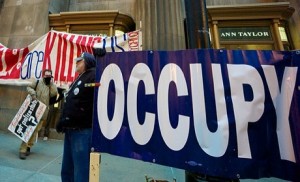Occupy Music: the human microphone

Maria Dubecki
Congress 2012 Correspondent
Speaker: Mic check
Crowd: MIC CHECK!
Speaker: Mic check
Crowd: MIC CHECK!
Speaker: We’re here today
Crowd: WE’RE HERE TODAY!
Speaker: To occupy Wall Street
Crowd: TO OCCUPY WALL STREET!
This copy-cat-like script is a written example of the protesting tactic known as the human microphone.
On Friday morning James Deaville gave an interactive and truly intriguing keynote presentation called Occupy Music: Collective Protest, Voice and ‘Microphonality.’ Deaville’s presentation – organized by the Canadian University Music Society – explored the musical and social functions of human voice in collective protest.
Specifically, Deaville focussed on the use of the human microphone (or the people’s microphone) in the Occupy Movements. As Deaville illustrated through both YouTube footage and audience participation, the human microphone uses crowd repetition to amplify and disseminate an individual’s message. Essentially, the crowd acts an a microphone for an individual speaker, repeating everything he/she says to make a message heard. In coming together, the crowd’s voices harmonize with each other, and therefore the human microphone also acts strongly on a musical level.
Within his presentation, Deaville shared comments from social networks such as Facebook, YouTube, and Twitter, and quotes from the limited scholarship that exists on the subject, to reveal the divided opinions facing human microphonality. For many, the human microphone has an exceptional and symbolic ability to foster group identity and collectivity, and bring awareness to a cause. Yet for others, the repetitive process is reminiscent of the sometimes ‘creepy’ atmosphere associated with oaths. Others still criticize the organization which often takes place when a speaker writes out the words of their speech instead of performing through improvisation, which many feel must be at the heart of the phenomenon.
Yet as Deaville explained in his presentation, these criticism downplay the fact that the human microphone works as a way to hear voices that might otherwise not be heard; the human microphone, through collective repetition, projects solidarity over individual ego – and does so with musical qualities.
Deaville also touched on the recent student protests occurring in Montreal, Quebec. He noted that the student protesters there refrain from using the human microphone particularly because the tactic is so strongly associated with the Occupy Movements. However, the Montreal protesters’ traditional tactics of rally oration through chanting, megaphone, and cupped-hand similarly project a united front.
This begs the question of which method is more effective. Ultimately, Deaville concluded that rich music is found everywhere people gather. Scholarship has largely focussed on glorified American Singer-Songwriters, such as Bob Dylan and Pete Seeger, to explore the role of music in protest. Deaville’s study, he hopes, will bring a new consideration to music scholars. And judging from the riveting question period and discussion that followed, this topic will be on many of our minds — and maybe even in our actions — moving forward.
Photo courtesy of World Can’t Wait on Flickr.Â









